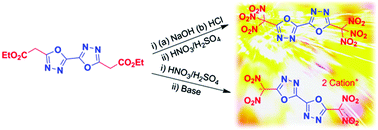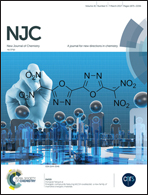Energetic compounds featuring bi(1,3,4-oxadiazole): a new family of insensitive energetic materials†
Abstract
In this contribution, 5,5′-bis(trinitromethyl)-2,2′-bi(1,3,4-oxadiazole) (4) and 11 nitrogen-rich salts featuring bi(1,3,4-oxadiazole) were synthesised. Compound 4 was obtained by nitration of 2,2′-bi(1,3,4-oxadiazolyl)-5,5′-diacetic acid and the salts (6, 8–17) were prepared by facile deprotonation and metathesis reactions. All compounds were characterized by IR, multinuclear NMR spectroscopy and elemental analysis. The structures of 6, 9 and 15 were further confirmed by single crystal X-ray diffraction. The physicochemical as well as energetic properties of these compounds including density, thermal stability and sensitivity were investigated. Except for 12 and 15, most of the salts decompose at temperatures over 180 °C. The performance data from the calculated heats of formation and experimental densities indicate that many of the salts have potential applications as energetic materials. The tested sensitivities of these compounds illustrate that they are less sensitive than RDX towards impact, friction and electrostatic discharge.



 Please wait while we load your content...
Please wait while we load your content...